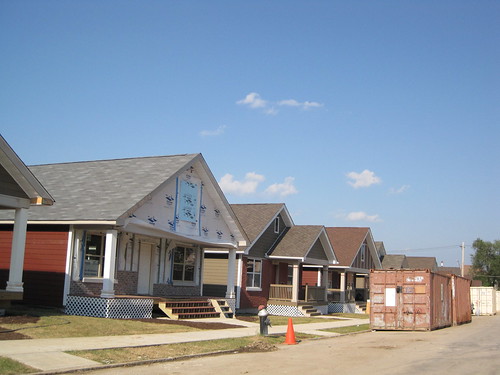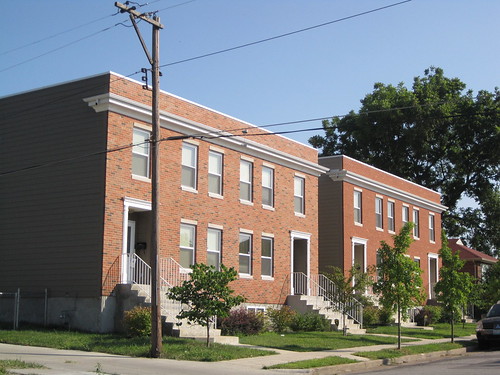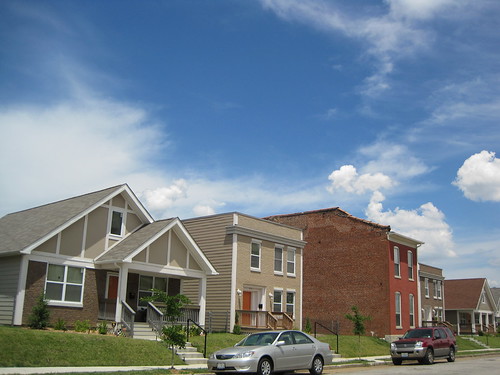by Michael R. Allen
 Thomas Avenue in the southeastern reaches of the JeffVanderLou neighborhood definitely is a construction zone. All day long, the street buzzes with the sound of large trucks, contractors speaking and power saws buzzing. The September deadline looms, and the developers are tough-minded about meeting that deadline. After all, these developers are known to be serious and uncompromising about their mission.
Thomas Avenue in the southeastern reaches of the JeffVanderLou neighborhood definitely is a construction zone. All day long, the street buzzes with the sound of large trucks, contractors speaking and power saws buzzing. The September deadline looms, and the developers are tough-minded about meeting that deadline. After all, these developers are known to be serious and uncompromising about their mission.
Has construction on the NorthSide project started in a big and visible way?
Not quite. The construction is part of a phased 90-house development, and sits fully engulfed by the boundaries of the NorthSide project. However, the developer is not McEagle Properties but the non-profit Habitat for Humanity. The project has not received tax increment financing, nor is is formally part of the larger and more visible development. The Habitat for Humanity project in JeffVanderLou is a modest, steady effort that will transform a few blocks and 90 families’ lives. If that is all that the project accomplishes — and I doubt that will be the end — it will have fulfilled a great need long before the larger project leads to even a shovel turn of earth.
Habitat for Humanity actually began this project in 2003, when it built 20 houses on Bacon, Garrison and St. Louis avenues in the northeast corner of the neighborhood. The St. Louis Equity Fund and the Jeff-Vander-Lou Initiative were development partners, and the Equity Fund remains involved in the subsequent phases. Neighborhood residents identified the need for this project as part of intensive community planning conducted as part of the Jeff-Vander-Lou Initiative process. This was development that came from the grassroots to serve the grassroots. These first homes largely consisted of two-story, flat-roofed townhouse-style buildings clad in brick and brick-like panels. Two of the double units on Bacon are shown here:
 Architectural critics can pick at the details and materials, but I think that the houses demonstrate a creative use of a limited budget. The houses are compatible in form with their urban surroundings, and each one occupies a vacant lot. Construction ameliorated the effect of 20 vacant parcels in a pocket of the neighborhood. Readers who have lived in areas where there are 20 or more vacant parcels in a two-block area know exactly how transformative that can be.
Architectural critics can pick at the details and materials, but I think that the houses demonstrate a creative use of a limited budget. The houses are compatible in form with their urban surroundings, and each one occupies a vacant lot. Construction ameliorated the effect of 20 vacant parcels in a pocket of the neighborhood. Readers who have lived in areas where there are 20 or more vacant parcels in a two-block area know exactly how transformative that can be.
 Like McEagle, Habitat for Humanity thought about JeffVanderLou on a large scale. The organization identified the need for more construction in the southeast part of the neighborhood, around the intersection of Sheridan Avenue and Martin Luther King Drive north of the reclaimed Blumeyer housing project. In summer 2008, Habitat for Humanity built 27 houses on Sheridan Avenue that received the Platinum LEED certification. As the photograph above shows, Habitat built around existing occupied buildings (there was some demolition of vacant buildings) and introduced a different house model.
Like McEagle, Habitat for Humanity thought about JeffVanderLou on a large scale. The organization identified the need for more construction in the southeast part of the neighborhood, around the intersection of Sheridan Avenue and Martin Luther King Drive north of the reclaimed Blumeyer housing project. In summer 2008, Habitat for Humanity built 27 houses on Sheridan Avenue that received the Platinum LEED certification. As the photograph above shows, Habitat built around existing occupied buildings (there was some demolition of vacant buildings) and introduced a different house model.
 The predominate house model is now a front-gabled, one-story home with front porch. Habitat for Humanity’s architects developed two different models that alternate on longer expanses. There are differences in material colors, and homeowners have chosen some personal variations like substituting actual brick veneer for the concrete brick-like material more common to the development.
The predominate house model is now a front-gabled, one-story home with front porch. Habitat for Humanity’s architects developed two different models that alternate on longer expanses. There are differences in material colors, and homeowners have chosen some personal variations like substituting actual brick veneer for the concrete brick-like material more common to the development.
I think that the one-story model is charming, especially with the generous front porches. These houses embrace the life of the street, sending a strong message in a neighborhood that still has a lot of street crime. Eyes and ears on those porches will make a positive difference.
The houses now under construction on Thomas east of Elliott are 24 one-story, 1,184-square-foot houses that will sell for $77,000 each. These homes are of modest scale and materials, but there are unique things about them in addition to affordable price: these houses also meet Platinum LEED certification standards. Not only are these houses satisfying necessity in the social economy, they are doing the same in the ecological economy.
When this phase ends in September, a final phase that concludes in December will be underway. By New Year’s Eve, 90 for-sale houses will have been added to JeffVanderLou in six years. That’s an impressive feat for non-profit developers working on a community-driven process. Even more impressive will be the social impact of the houses.
As we contemplate the redevelopment ordinance that will initiate a much larger, private vision of development for this area, we should not forget that our best successes come from dreaming big but working small. Those who say that the scale of the solution must match the scale of the problem are right, but they are overlooking the scale of the community. As the Habitat for Humanity project shows, block by block makes a difference — and adds up to big results quicker than we think.
Some photographs of the Habitat for Humanity project are online here. Television station KETC’s Living St. Louis produced a segment on the project that appears online here.
